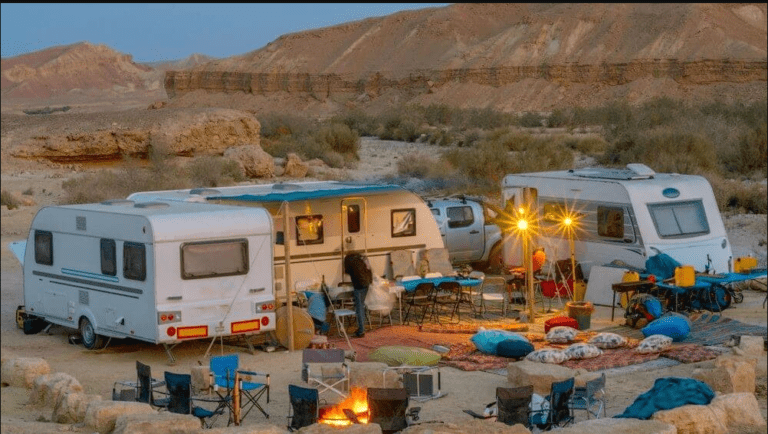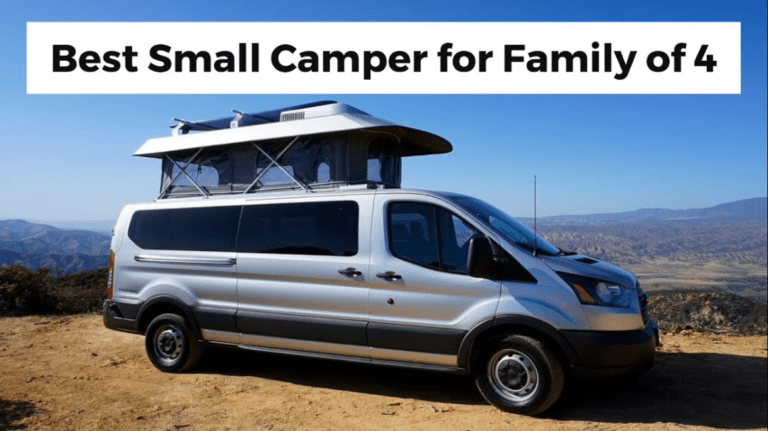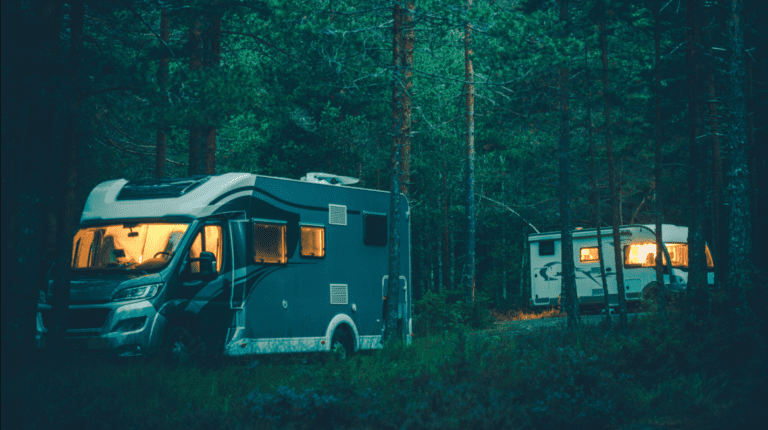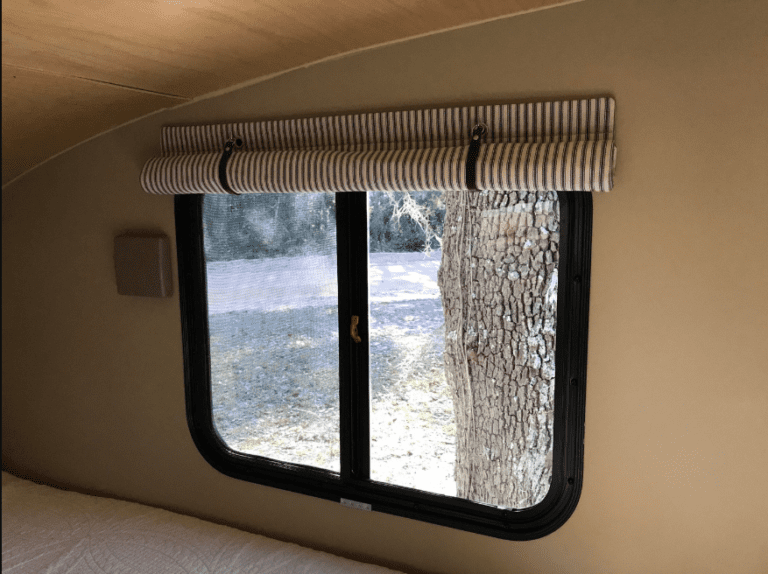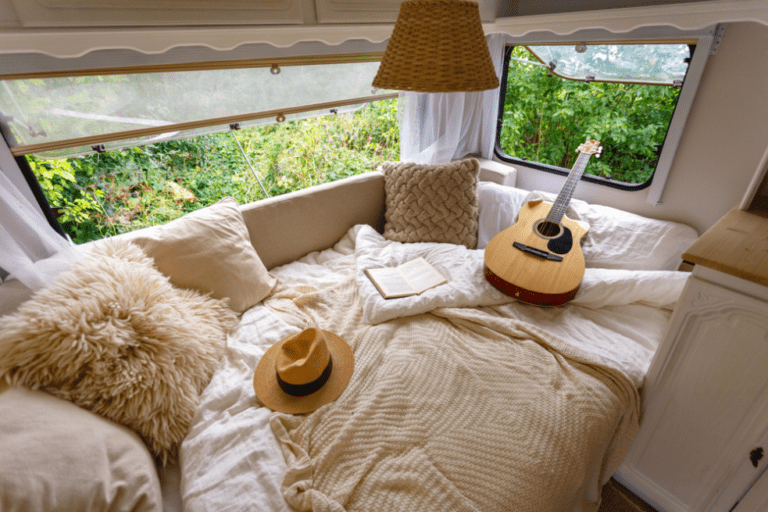How to keep your RV cool

Stay cool without A/C in your RV
Summer is upon us, so it’s time to prepare for the warm weather. Traveling in an RV is great, but running the air conditioning constantly can be a big drain on your battery. If you want to save energy or don’t have an active system, it’s important to know how to stay cool without A/C.
It takes much less energy to maintain a cooler temperature than it does to convert a hot RV to a cooler one. Even if you decide to run your A/C, you can save energy by making some habits that will keep the interior nice and cool.
Below we have some tips that will help your RV (and the passengers inside) stay cool without A/C. These range from internal upgrades to quick cooldown hacks. Try implementing some of these ideas during your travels this summer and see how easy it is to achieve without relying solely on an air conditioner.
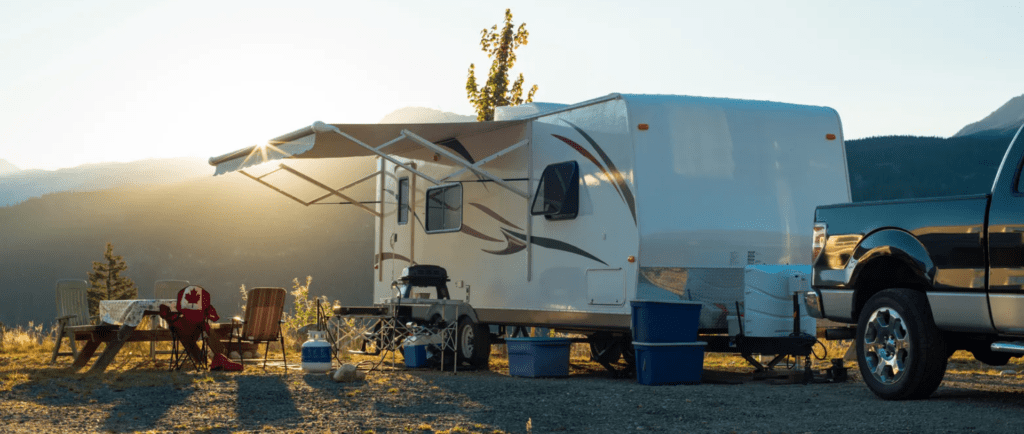
Cover the windows.
Getting natural light into your RV is a great way to brighten up the space, but it also invites a lot of heat inside. If sunlight is allowed to enter your RV without a buffer, it can raise the temperature by 10 degrees or more. It can become inflamed quickly, especially if there is no way to escape the heat.
Covering your windows is the first line of defense. You can use anything as long as it blocks incoming radiation. Curtains and blinds are easy to install, but sometimes a more heavy-duty solution is necessary.
Reflective window covers are great for cooling vehicles. Just put reflective covers on doors and windows whenever you need to reduce the temperature. There are also blackout coverings you can stick on your windows if you want full coverage.
Use a swamp cooler.
Swamp coolers (also known as evaporative coolers) are a fantastic solution for a hot RV. These coolers use old principles to cool their surroundings. When warm air passes over the liquid, some of the liquid evaporates and cools the air.
If you are looking for a good option, the Hessaire MC37M Evaporative Air Cooler is a great choice. If you’re interested in a DIY approach, you can also make your own swamp cooler. Follow the video below to stay cool without A/C.
Unfortunately, swamp coolers won’t work everywhere. They need warm, dry air to work effectively. If you’re camping in a humid area, these coolers won’t be nearly as effective because the air is already so humid. But if you’re camping in a dry environment, it can be a real lifesaver!
Try electric fans.
Electric fans are an easy solution to staying cool. Although they do not include evaporative cooling, they improve air circulation and help prevent inflammatory conditions. You can also run multiple fans at the same time and place them in your RV.
Small fans do not use much energy and are quite useful for travelers trying to go without A/C. The Honeywell HT-900 is a compact and high-quality fan that will be perfect for RVers.
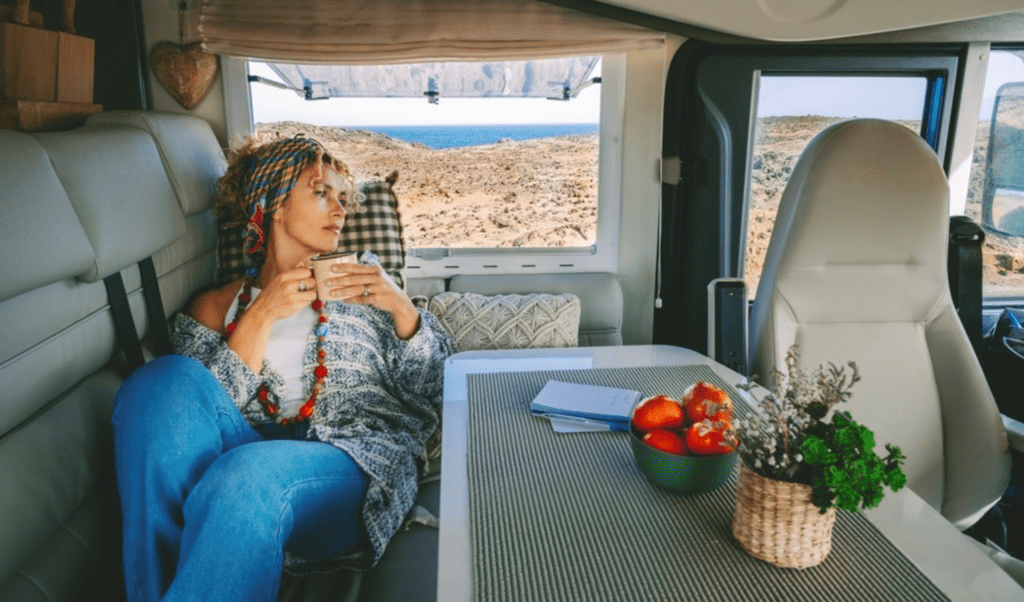
Switch to breathable bedding.
Being hot during the day is annoying, but being hot at night is bad. If you’re like me, it’s hard to sleep when it’s really hot. You might be tossing and turning all night, sweating and trying to find the cool side of your pillow.
One way to stay cool in your RV without A/C is to change your bedding during the warmer months. While you may love to bundle up at night, heavy comforters and flannel sheets will become suffocating. Go for light, breathable bedding like cotton and linen.
If you use a memory foam topper for your bed, there are also cooling gel toppers that you can add in the summer. This will cool the bed itself and make it easier to sleep.
Keep windows open at night, closed during the day
A good air flow is essential to keep your RV temperature stable. Fortunately, you can let the natural heat cycle outside do most of the work for you. Even if you have air conditioning, cooling the entire RV can take a lot of time and energy.
If you want to rely on your RV’s natural insulation, try opening your windows at night to let cool air in. Close them in the morning as the temperature rises. Avoid opening and closing doors during the day as this will allow hot air to enter. Make sure you use bug nets on your windows to keep bugs out while you let the cool air in.
This method works well in homes and RVs, so give it a try.
Cooking outside
You may also need to change your cooking habits if you want to stay cool without A/C. Cooking indoors will raise the temperature, especially if you use the stove and oven a lot. Even with good ventilation, you’re bound to raise the temperature a few degrees.
So, if the weather is warming up, try taking your culinary adventures outside. Most campsites will provide fire pits and picnic tables, so you can do most of your meal preparation and cooking outside. If you have an outdoor kitchen, it’s even better!
Invest in an ice maker.
Nothing cools me down like an ice cold drink. Many RVs have refrigerators and freezers, but they don’t always have an ice maker. Some campsites have snow that you can purchase, but again, this is not guaranteed.
If you’re interested in making your own ice, try a countertop ice maker like the Cylon Self-Cleaning Ice Machine. It makes nine ice cubes at a time and it can freeze them in just six minutes. It also makes different sizes of ice, so you can choose the ice you need at any time.
A good ice maker will help everyone stay nice and cool, no matter how hot the environment is. For more portable ice makers, check out our top picks here.
Take a lukewarm shower.
Sometimes you may need a full body cool down. If you’re sweating and overheated, you may think a cold shower is the way to go. While this will provide some temporary relief, it can actually make things worse in the end. Your body will compensate for the heat loss and soon you will be back where you started.
A warm shower will prevent you from overheating, plus it will cool you down after you work out. As water evaporates from your skin, there will be a secondary cooling effect. Plus, a lukewarm shower won’t be as shocking to your system as a cold one.
Cool the areas with high blood flow.
Sometimes you need to cool off, but you don’t want to take a shower. In this case, you can focus your efforts on the parts of your body that have the most pulse and blood flow. This includes your neck, wrists and feet.
Apply an ice pack or cold washcloth to these areas and see the results. You’ll cool down quickly with minimal effort. Another great way to cool down is by soaking your feet in cold water.
Even if you don’t have air conditioning, you can still find ways to beat the heat this summer! For help mapping your route to your next RV getaway, look no further than the RV LIFE Trip Wizard. This online planning tool makes it easy to plan an RV-safe route. It can also find interesting sites along the way based on your travel preferences.
The table of contents is hidden.
- Park in the shade
- Use your sheets.
- Open a window and run your ceiling fan.
- Use indoor/personal fans.
- 4.1) Sirocco II 12V/24V Fan
- 4.2) O2COOL Treva 10-inch Portable Desktop Air Circulation Battery Fan, 2 Speed, Compact Folding and Tilt Design, with AC Adapter
- 4.3) Geek Aire 19,200mAh Rechargeable Battery Operated Floor Fan, Powered Fast Air Circulation Fan, Up to 30 Hours
- Reflective window coverings
- Leave your RV.
- Use an insulator when not running your RV vent fan.
- Cooking outside
- Upgrade to LED lights/bulbs.
- Stay well hydrated and use personal cooling items.
- 10.1) Mission Cooling Neck Gaiter
- 10.2) Columbia Fraser Zero II Neck Gator
- Move your location.
- How do you stay cool in the summer heat?
Park in the shade
When possible, position your rig in the shade. Even if you’re going to a store or restaurant, find shade to keep your RV cool, especially during the hottest part of the day.
Now – if you have solar panels on your roof, this can be a bit tricky, as you don’t want to expose those panels to the brightest sun of the day. That sun gives you the strongest energy. So, you have to weigh this issue and balance the solar energy needs with the cooling benefit of parking in the shade.
We take special advantage of the sun when we tilt our panels as you may have seen in our post “Should I Tilt My Solar Panels?”. We’ve been tilting our solar panels for years, and we’ve gathered a lot of evidence that it really does make a difference in the amount of power output that solar provides.
A large solar array like ours can help keep an RV cool in the summer.
We have a fairly large solar array and the ability to harness the sun’s power by tilting our half of the solar end accordingly.
Of course, if your entire rig is in the shade and your solar panels are not exposed to the sun, it doesn’t matter much. So, again – it’s all about balance.
One shade parking option to keep your RV cool, while taking advantage of solar panels, is to use portable solar panels for your RV. That way, you can place your portable solar panels in the sun, far away from the cool spot of the RV under shade trees.
Photo of solar panels in the sun while the RV is parked in the shade to keep the RV cool in the summer.
Portable solar panels can be placed in direct sunlight while your RV is parked in the shade.
Either way, keeping the sun out as much as possible is an important way to keep your RV cool in the summer heat.
Use your sheets.
Even if we can’t park our RV in the shade, we like to take advantage of our tough top awning and privacy panels to keep the heat out of our RV. If you have a patio awning, use it to shade the sunny side of your RV during the afternoon heat.
If you also have RV window awnings (like we do), use them to your advantage as well. It’s amazing how much heat is removed from your RV when your awning is up.
Open a window and run your ceiling fan.
If you’ve never run your RV roof vent fan in the rig with an open window or two, you won’t believe how powerful this tip is for keeping your RV cool in the summer.
Many RVers run a ceiling fan with an open window in the rig to stay cool, and they rarely need to use the AC, (depending on where they travel, of course). It cools the RV wonderfully, but you need to make sure you stay on top of any necessary maintenance on your roof vent fan. The last thing you want to do is head out on a camping adventure without a working vent fan.
So as we make our way into summer, now is a great time to check the condition of your RV ceiling fan. If you need to replace your fan, we’ve got you covered in our post on the 3 best RV roof vent fans , and our companion post offers step-by-step instructions for RV roof vent fan replacement.
This is a great DIY project if you’re comfortable working on your own roof. As always, be careful on the roof, and make sure you have the tools and components you need before you begin.
If all of your existing RV vent fans need a good cleaning, follow these steps as we super clean the RV Fantastic Vent Fan:
Use indoor/personal fans.
Sometimes a personal fan, or an additional interior fan, may be all you need to keep your RV cool, depending on your ability or desire to run your AC. A little air can go a long way in a rig, and these fans have great reviews among RVers.
Sirocco II 12V/24V Fan
Caframo’s Sirocco and Sirocco II fans have long been popular with RVers and van campers. Despite the low power consumption, the amount of air these fans are able to move is reportedly impressive. To top it all off, they’re made in North America and come with a two-year warranty.
- SALESEEKR by Caframo, Sirocco II Fan, Omni-Directional Gimbal Fan for Boats and RVs, Made in Canada, Auto-Sensing DC, 12V/24V, Black
- Innovative Gambled Design Offers Full 360 Degree Airflow
- Versatile 12/24V auto-sensing capability
- O2COOL Treva 10-inch Portable Desktop Air Circulation Battery Fan, 2 Speed, Compact Folding and Tilt Design, with AC Adapter
It’s a more personal, in-your-face fan – something that can run directly on you either at your desk, on the kitchen table, or on your bedside table. The 10-inch blades are noted to propel plenty of air, and two speeds are offered.
The fan folds up for easy storage and operates via battery power (6 D cells) or an AC adapter.
Triva 10 Inch Portable Desktop Air Circulation Battery Fan, 2 Speed, Compact Folding and Tilt Design, with AC Adapter (Graphite)
Triva 10 Inch Portable Desktop Air Circulation Battery Fan, 2 Speed, Compact Folding and Tilt Design, with AC Adapter (Graphite)
Battery powered portable fan. With O2COOL’s 10-inch battery-powered portable fan, you can cool down when you’re at home, at work, or out and about.
Durable construction. Durably manufactured using sturdy plastic construction for long-lasting strength and use, this portable fan boasts a patented fan…
- Geek Aire 19,200mAh Rechargeable Battery Operated Floor Fan, Powered Fast Air Circulating Fan, Up to 30 Hours
It’s a portable metal fan with 12-inch blades that runs for up to 30 hours on a rechargeable lithium-ion battery. It comes with a 26.5V power adapter that charges the fan in 2.5-3.5 hours.
Reviewers note that these fans push a powerful airflow and can be used outdoors. It has the longest-lasting battery, but Geek Aire makes other versions of this fan that include larger 16-inch blades to move more air.
- SALEGeek Aire 19200mAh Rechargeable Battery Operated Floor Fan, Powered Fast Air Circulating Fan, Up to 30 Hours, Portable Metal Fan for Outdoor Camper Golf Car, Travel Hurricane or Indoor, 12 Inch…
- Geek Aire 19200mAh Rechargeable Battery Operated Floor Fan, Powered Fast Air Circulating Fan, Up to 30 Hours, Portable Metal Fan for Outdoor Camper Golf Car, Travel Hurricane or Indoor, 12 Inch…
Reflective window coverings
Reflective window coverings are great for keeping the sun’s heat from heating the contents of your RV. Many campers use Reflectix or a similar foil-over-bubble-wrap insulation material to make window covers for each window in their rigs.
This product comes in a roll, and you can use the paper to make your window patterns, and then cut the Reflectix to size, leaving ½ inch or so around the perimeter of each one. Increases so that it fits comfortably in the window frame. . the location. Insulation usually slides into the window frame very easily and holds there very well.
Reflectix BP48010 Double Pack Insulation, 48 in. x 10 ft
Keeping the sun’s heat away from your RV as much as possible, whether by parking in the shade or insulating your windows, is a great way to keep your RV cool this summer.
Leave your RV
A great way to cool off in the heat of a summer afternoon is to get out of your RV and visit forests, beaches, creeks, streams, rivers, oceans, or any other attractions near where you’re camping. Find the
Kayaking, paddle boarding, swimming, and hiking in the shade are all wonderful activities that will not only feed the body and soul, but also keep you out of the RV during the hottest part of the day.
Use an insulator when not running your RV vent fan.
Insulating your vent fan when not in use is very helpful in preventing both summer heat (and winter cold) from entering your RV. And if your RV has a skylight, it’s a great idea to insulate the opening from the sun when the weather warms up. Skylights and ceiling vent fans don’t provide much insulation, so they’re the perfect place to turn in the summer heat (or winter cold).
These are a standard size, but be sure to measure the opening in your RV just to be sure it will fit. They are not expensive, and they work well. Just push them open and you’ll likely see the internal temperature of your RV drop.
Cooking outside
When it’s hot outside and you’re trying to keep your RV cool, using your indoor stove or oven will make it even warmer. Consider cooking outside when you’re camping in warm weather. If you’re connected to shore power (or have a generator you don’t mind running briefly or a large enough battery bank), you can also use your microwave to heat up food quickly. can do Or, you can choose to eat cold food instead, and avoid generating any extra heat.
Upgrade to LED lights/bulbs.
LED lighting is one of the best investments you can make in your RV. Yes, we know – it seems like a no-brainer. But it is not so. Not only will LED lighting save you a lot of electricity (which is especially beneficial when you’re boondocking), but LED lights are also cooler than incandescent lights.
When you’re trying to keep your RV cool in the summer heat, every little bit helps. To help, switch out your standard light bulbs/fixtures for LED lights, and you’ll definitely notice the difference.
Stay well hydrated and use personal cooling items.
When you’re camping or participating in activities in the heat and humidity of summer, it’s especially important to stay well hydrated. Always carry water with you no matter where you are or what activity you are enjoying. Even when you’re out in the summer sun, water activities require constant hydration.
Move your location.
One of the great things about RVing is that you can take the wheels on your camper and move to a location that suits your health, fitness and enjoyment. So, sometimes the best way to beat the heat is to pack up and move to cooler climates or higher altitudes. Or maybe you just need to abandon your boondocking plans and go full hookup to run your A/C!
1. Relax under your RV awning and shade rooms.
RV awning shade
RV awnings are designed to extend your living space and provide shade coverage. It’s hard to find an RVer who doesn’t benefit from this essential accessory, but taking the time to create a lounge-worthy space under your awning will make it more appealing when the sun’s rays beat down on your interior. It will be heating.
Spending the day on some comfortable outdoor furniture isn’t a bad way to spend your time, especially since the shade provides much-needed relief from the intense sun. You can further your cooling efforts and expand your living space by building an RV shed. There are many awning accessories available that are designed to attach to your awning to create a whole extra room.
If you’re not looking for a full enclosure, there are also simple sun-blocking materials available that you can attach to your awning.
2. Block light entering through your windows.
Window awnings to cool the RV
Most of the heat that enters your RV comes through your windows. Because of this, you’ll want to minimize the amount of natural light entering. You can do this by installing window shades and window shades.
Window shades are made of materials that block light, and they act like blinds. Some are even transparent so you can still see outside.
Window shades attach to the outside of your windows, and they significantly reduce the amount of sunlight that enters when they are retracted.
If you’re on a budget, many RVers use the inexpensive DIY option of installing reflective insulation (e.g., Reflectix is a popular brand), which helps reflect the sun away from your windows and reduce heat transfer.
3. Park in the shade
Parking in the shade to keep your RV cool
One small thing that will make a big difference is the purpose of where and how you park your RV. If you’re staying at a campground, call ahead and try to reserve a spot with plenty of shade. Naturally, this will keep your RV cooler (and protect your RV tires from UV light).
Additionally, you can figure out which direction the sun is coming from, and angle your parking lot so that your RV faces that direction with the most windows.
4. Hydrate well.
Stay hydrated to keep cool
During your summer RV trip, staying hydrated is very important. You’re sweating profusely, which means you’re losing moisture and essential electrolytes. Commonly heard advice is to drink eight 8-ounce glasses of water per day, but factors such as lifestyle, age, gender, weight and weather affect the amount needed.
Mild dehydration can lead to headaches and dizziness, while severe dehydration can lead to serious health conditions, such as heat stroke (this article will help you know the signs of dehydration). Since you’ll be on the move a lot while RVing, you’ll need to be especially active to make sure you’re getting enough fluids.
Be extra generous when preparing your water supply for your trip, especially if you’re boondocking. Keep your water tank full, buy extra drinking water jugs, invest in a quality water filter that you can use on streams and rivers, and do whatever you can to conserve water. It will help to make sure you stay hydrated enough.
5. Do not cook inside during the day
Eat outside your camper.
If your RV is already uncomfortably hot, avoid making things worse by trying to use the stove or oven during the day. Doing so will significantly increase the internal temperature.
Instead, plan ahead, and eat foods that are cold, such as green salads, cold sandwiches, savory bruschettas, fruit plates, or pasta salads. If you really want something hot, try eating something that can easily be microwaved.
Alternatively, get a portable grill so you can cook outside in the shade!
6. Enjoy the cool elements outside.
Cooling off
If the sun is busy baking inside your RV, take the time to find natural solutions to the great outdoors.
Swimming, boating, kayaking, river swimming/tubing are some of the options at your disposal. Some RV parks also offer boating and swimming facilities, so you won’t have to stray too far from where you camp.
When it’s scorching hot outside, taking a dip in cool, natural water can be a wonderful experience, one that will sit comfortably in your memories of that summer adventure.
Just remember the sunscreen!
7. Move to cooler temperatures.
Cool places
If you try the above tips and still can’t stand the heat, remember you’re mobile. One of the benefits of owning an RV is the ability to change locations. If you also have the free time and resources to head somewhere cool, by all means, take advantage of the option.
Areas in the Pacific Northwest, such as Lincoln City, Oregon or the Bay Area, are known for being relatively cool year-round, and they’re also absolutely beautiful. There is also much to do in this part of the country. Being able to hike in the mountains one day and visit the beach the next is the perfect combination of amazing sightseeing that you will never forget.
If you’re not ready to travel a lot to a cool place, consider something simpler. If you’re just looking for a quick break from the heat, consider getting a hotel or cabin for a few days. This would be a fun way to break up your commute and lounge in some cooler temperatures.
Stay cool!
Summer travel often leads to life-affirming memories and exhilarating experiences, but the unrelenting heat can certainly lead to feelings of sweaty discomfort. Hopefully now you know how to keep your RV cool in the summer, without melting.
You can also get a portable air conditioner for your RV to make the summer heat more bearable.
Ventilation
Once you have the RV set up optimally, the next thing is to ventilate the rig. The purpose here is to bring in fresh cool air and expel hot air. The goal is not to get the inside of the rig hotter than the outside ambient air temperature. Close any windows that are on the warm, sunny side and open any windows that are on the shady side. I then open the roof vents to let the hot air out.
Warm air rises so hopefully you have some natural convection going on in the cold air and pushing the warm air out. You can add some fans to help with this convention effect. We recently installed a quiet but very high output roof vent fan called the Fan-Tastic Fan. It draws very little power and works like a charm creating a nice breeze in the RV.
Once the sun goes down and the temperature outside starts to cool, open your storage bays and closets and try to let the heat out before you go to bed.
RV refrigerator vent
Another area to pay attention to in terms of ventilation is the refrigerator. As the refrigerator cools our food it also produces a lot of heat that can get trapped in the RV. This heat needs to be removed. Most units have an external vent in the roof or side of the RV. If you can shade the exterior fridge panels, it will help the fridge run cooler and more efficiently.
Also, a fan in the ventilation area of the fridge works well to remove all that heat build-up. Our rig came with a small temperature control fan in the fridge vent stack and I could hear it running on a hot day removing excess heat. I also plan to install some additional fans on my roof. I have seen an alternative roof vent hood online with solar powered fans that sounds like a great idea!
Check and make sure the refrigerator vent areas are clean and not blocked by any debris.
Shower skylight
I am amazed at how hot our shower skylight gets on a sunny day. I’ve heard of some people painting over the stuff to keep the heat out. Last summer I took the inner cover apart and put some reflective bubble insulation in there and it did a good job of keeping the heat out.
Another option is to use velcro tape and attach a sunblock panel if needed. The only caveat is that it is possible to generate too much reflected heat on the domed plastic cover and possibly crack it. I guess you could experiment using an infrared heat gun and see how much hotter the outer plastic dome gets than normal.
Carry some tarps.
Carrying a tarp or two is a good idea for all sorts of things when RVing. They can be very useful by providing instant shade. Attach one to an awning, RV or nearby tree for extra shade.
Use LED lighting and turn off electronics.
You’d be surprised how much heat those small OEM incandescent or halogen lamps put into the RV compared to LED replacements. While LED lamps heat up a bit, regular bulbs are like running small heaters.
LED-replacement-bulb
Turn off any electronics or chargers that are not in use. All of them can add a little heat and add more warmth to the RV.
Swamp Cooler?
I haven’t tried one in the RV yet but I had a little evaporative cooler when we had the house and it worked great. You just added water and the little fan pushed the air through the wet filter and it cooled the air. There are many interesting designs on the internet. Sounds like an interesting DIY project.
Cooking outside
It’s best to try to keep all the cooking heat out. Use the barbecue or camp stove to prepare your own food, coffee and tea. Instead of using a hot RV gas oven, try cooking outside in a crock pot, Instant Pot or Dutch oven.
Close window shades and add blackout curtains.
If you are not planning to cover the windows with reflective insulation, make sure all window shades are closed during the day to further prevent the sun from hitting the windows and heating the interior of the RV. Add blackout curtains.
Use a dehumidifier if camping in humid areas.
If you plan to park anywhere with high humidity, running a dehumidifier will make the interior of your RV significantly cooler and more comfortable.
Turn off the lights during the day.
If your RV lights have incandescent or halogen bulbs, turn them off during the day. These types of bulbs emit heat and will raise the temperature of small, enclosed spaces like your RV. Better yet – change all bulbs to LEDs – in the long run it saves money by keeping things cooler and not needing to be replaced as often.
Add a roof shading system.
If parking in a shaded area isn’t an option, try installing a product that provides permanent shade for your RV, like an RV shade. It protects your RV roof and blocks 95% of UV rays.
Insulate every space around doors, windows and vents.
Carefully inspect all your windows, vents and doors and then add insulation.
Place the reflectives on top of the sliders
Reflectix is a flexible insulation material (looks like silver bubble wrap) that you can buy in large rolls to cut to the size you want. Measure the roof size of your RV sliders and cut a piece of reflective insulation to fit over the top. Secure with Velcro tape (the kind you can stick to surfaces). You’ll have to reapply that roof insulation every time you open your sliders – but it will help keep the sun’s heat out of your camper.
Add an RV airflow system.
Cold air naturally condenses on the ground while warm air rises to the roof of your RV. Using an airflow system such as RV Airflow will circulate your RV air and keep the camper cool.
Cover skylights.
Secure the reflectors to the interior of your skylights using Velcro tape to prevent the sun from shining through those windows.
Pre-cool your RV.
If you know it’s going to be a disaster for a day, start your AC early, before it gets really hot. You’ll cool the walls and floors of the camper and help keep things from overheating. It takes less energy to keep an RV in constant cooling than to wait until it gets too hot and try to cool it from there.
Ventilation
The main purpose of good ventilation is to get hot air out and fresh air in. You can install vent covers over your existing roof vents to help increase ventilation in your RV – they let fresh air in even when it’s raining. Close all the windows on the sunny side and open the windows on the shady side – this allows the hot air to escape.
Install a ventilation fan in the refrigerator vent.
Your RV refrigerator gives off a lot of heat when it’s running (which should be 24/7). Your RV should have a roof vent near the refrigerator or right above the refrigerator. Purchase a small ventilation fan that fits over the vent to draw warm air out of the refrigerator. Also, make a special effort to include this vent in your monthly vent cleaning as any debris blocking it will affect the RV’s interior temperature.
Portable fans
Place a few small fans around the RV to help keep the air circulating and cool. Even small USB-powered fans are really useful for keeping the air cool.
Use a vent cover when running the AC.
Cover all vents securely when running your AC to keep your RV sealed and minimize any outside air from heating your interior AC air. In the bathroom, use velcro tape to secure the vent cover so it can be removed for showers (you want to keep the vent open to release steam and water vapor).
“Shut that door! We’re not air conditioning the whole neighborhood!”
Dad was right, keep that door closed as much as possible to keep your AC air in and hot, humid air out.
Inspect your AC duct system.
It’s a scary fact, but not everything on your RV may have been installed correctly at the time of manufacture. Inspect your AC ducts and make sure all spaces between supply and return are properly sealed. You can lose a lot of cold air on the return if they are not sealed properly.
Be careful about prolonged stays near salt water
Salt in the air can damage your AC unit over time. If you plan to camp near the ocean, remember that it’s especially important to have your AC professionally maintained annually to minimize the effects of salt and its cooling capacity.
Awning facing south/southeast
This scenario is best if it’s not too hot, no higher than the mid-80s. You can partially shade your RV from the intense afternoon heat this way.
Then use your vent fans and interior fans to keep the air moving.
A travel trailer with boondocking in Valley of the Gods, Utah
Of course, if you’re in a campground and can’t choose your campsite, you may have zero orientation options for keeping your RV perfectly cool.
Also, remember that you may not always be able to use your awning. If it’s windy, it should come in. Then it won’t do you any good.
An awning? Use a tarp or portable awning.
If you don’t have an awning, portable awnings are available in the market, such as moon shade awnings.
Or, you can hack it – make your own canopy using a tarp or similar.
A fifth wheel trailer using a shade cloth over the large window
A little is better than nothing! They did this only to shade the large window of their room.
Attach a large tarp to the top of the south side of your RV and secure it to the ground using stakes or another attachment method.
It’s even better if you create an air space between the RV and the tarp.
If you choose to park with your door facing north, this is your best option to help shade the sunny side of your RV without using an awning (assuming you have South is the side towards the Sun).
Or, use a south-facing portable for optimal RV cooling.
Shade your roof with a Shade RV.
Shade RV is a product that covers your roof to create shade when you can’t park under something. This may be the most expensive option on the list, but it’s also the most effective. Using a shade RV is a great solution if you don’t move around much or are in full sun in a hot climate like Arizona.
Maximize the effectiveness of the vent fan.
What if you can’t use your AC? In this case, your vent fan is your next best friend in keeping your RV cool.
Fantastic RV Vent Fan
When it’s not too hot, and you only have a vent fan and a small RV, I’d recommend just opening one window.
Because if you move between an open window and a fan, you’ll get airflow with cross air.
If you have two fans, set one to draw air in and the other to blow hot air out. This will also help with crossbreezes.
If you have a stock fan that isn’t a Fantastic Fan or a MaxxAir fan, replacing it with one will do you the world of good.
Usually stock fans have a small fan that barely pulls hot air in or out. Very lame.
Insulator for RV vent fan and skylight
If you use your AC, close the cover and put foam insulators in your vent fan area to help keep the heat out.
Insulating cushion for RV vent fan opening
If your vent fan is attached to your ceiling or has a skylight, you can purchase a vent cover that has insulation or a skylight shade.
Some RVers put a little Reflectix in there too. I find the foam works well enough – no heat gets through without my reflectors.
They are very cheap but effective.
Find them at any camping store, on Amazon, or even at Walmart. Or, make your own.
Add blinds.
Most RVs come with blinds, but if you don’t have one, it’s a no-brainer.
If possible, add insulation such as honeycomb cellular window shades or an insulating material.
Insulated curtains are also helpful.
Minimize the use of your stove.
Stoves are hot when turned on, ugh. The less you use in high temperatures, the better.
Try using the microwave instead. Or cook outside using an outdoor grill, sun oven, or fire pit.
However, if you must use your stove, put the pot or pan outside immediately after you’re done.
It makes no sense to cool it inside your RV, heating up your camper or motorhome any more.
Finally, you can choose to eat foods that don’t require cooking, such as salads, sandwiches, and granola.
Use stand-alone fans.
It may seem like a no-brainer, but sometimes relying on just a ceiling fan (or just a ceiling fan, like in fifth wheels) just isn’t enough.
The truth is, the more air movement you have, the better.
12 volt box fan
So, buy yourself some standalone fans.
You can do 120 volt or 12 volt fans, depending on how often you are off grid and if you have an inverter.
120 volts will likely be more powerful. But 12-volt fans will also help give you some cool, fresh air.
Use a dehumidifier.
If you’re on the East Coast and in high humidity, dehumidifying the air helps make your environment more comfortable.
Make your AC vents more efficient
Okay, so it’s hot enough that you’re using your AC?
RV trailer air conditioner outlet vent
FYI- If you have this style vent on your roof, you can rotate it to push the air where you want it.
AC is usually enough, but when it’s so hot that your AC can hardly keep up, try these two tips.
If you have a large RV with multiple ‘rooms’, close the vents to the rooms you are not using (and close the doors).
If possible, point the vents toward where you are sitting or standing in your RV for maximum cooling effect.
Make sure you clean your AC filter or filters. Too much dust and dirt in them can slow down your AC.
Chase the high elevation.
The warmer it is (and the more you love the mountains), the higher you want to be. It’s cold there!
Of course, this only applies if you are location independent and ready to move.
Denali National Park River Meadow Mountains
No, it is not the most cost-effective solution.
But chasing altitude while in an RV full-time is the most effective (and adventurous) solution to the heat.
For every 1,000 feet you climb, it gets about 3.5 degrees cooler. If it’s not humid or raining/snowing, it will be even colder.
Where is your water hose?
Well, it won’t do anything to keep your motorhome or travel trailer cool in the summer, but it will make your hot days a little better.
- Camco Taste Pure Drinking Hose
If your water hose sits in the sun, the water inside will heat up. (bake!)
Shade your hose if possible. Do not let it sit outside on a hot floor.
If you put it under your RV or cover it, your rig water won’t get sickly hot.
Homemade swamp coolers to keep your RV cool
Search the internet for ‘homemade swamp cooler’, and you’ll find many ways to make one.
They are simple, easy to make, and all have the same base.
This unit uses a fan to move the air over falling water or snow to cool the air. Water or ice vapor cools the air.
Homemade versions are often made from a cooler or bucket. Minimal parts required.
The parts are a fan, a water pump, a container, a small tube and water. Cheap and easy!
For maximum cooling effectiveness, the homemade swamp cooler should stay outside (or vent to the outside) of your RV.
Close the inner door!
If you have rooms you are not using during the day, such as a bedroom in a fifth wheel, close that room and close the vents. There’s no point in wasting precious cool air in that room – vent it into your RV’s living space for maximum efficiency.
The bottom line on keeping your RV cool
With or without AC there are many ways you can keep your RV cool on your adventures.
However, despite the best of these ideas, unless you’re using your air conditioning, it can be pretty miserable if your temperature is above about 85 degrees and you’re not in the shade.
Woman leaning out of RV door.
You may even benefit from lining the bottom of your RV (like skirting) as some people do in the winter.
Skirting also helps keep the RV cooler in the summer.
For recovery, your best lines of defense are:
- Chase height
- Park in the shade.
- Use your RV as shade.
- Use your roof vent fans.
- Install insulated curtains, shades or roller blinds.
- Center your RV air conditioner vents on yourself if applicable.
- Angle your RV so the windows don’t get as much sun
- Use your awning and/or shade cloth.
- Minimize stove use.
- Use a stand-alone fan for maximum ventilation.
- Get a swamp cooler.
- If using AC, cover the vent fan.
- Mirror your windows and possibly closets.
- Angle park for maximum shading where you need it.
- Use LED lights.
- Get a dehumidifier.
- Shade your water hose.
- Add blinds/shades.
- Close the doors of rooms that are not in use.
